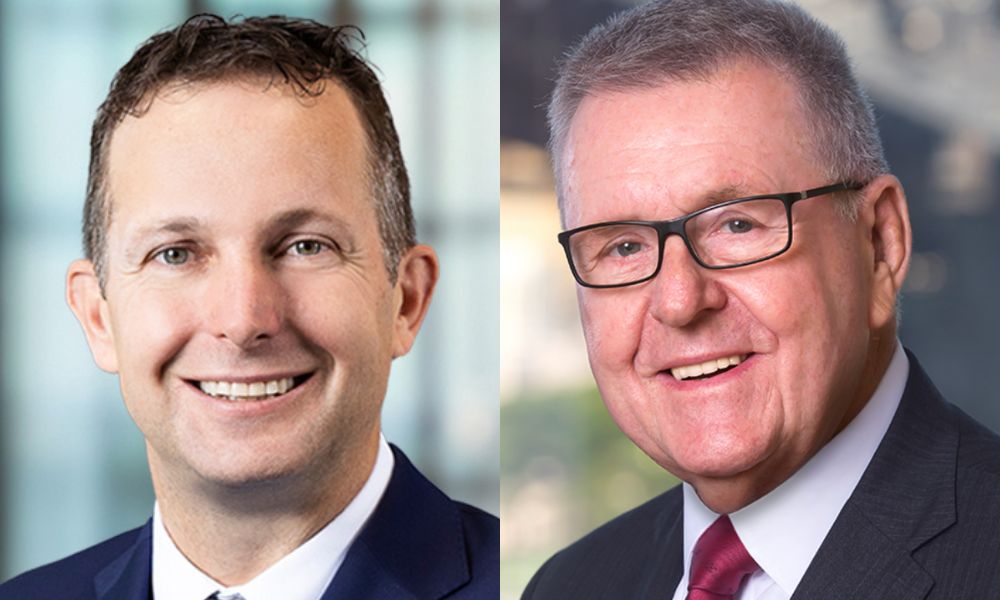Is Australia’s intermediated market growing?

Is Australia’s intermediated market growing? | Insurance Business Australia
Insurance News
Is Australia’s intermediated market growing?
“The value of the broker continues to increase,” says head
Insurance News
By
Daniel Wood
Data shared by Steadfast Group, the giant brokerage network, shows that despite economic and direct insurance challenges, Australia’s brokers have expanded their share of the general insurance market.
“The value of the broker continues to increase,” said Nigel Fitzgerald (pictured above left) during Monday’s Steadfast Investor Day presentation.
The presentation followed the firm’s Friday announcement that its FY24 results are expected to either reach the top end or exceed previous guidance range. Steadfast generated about $14 billion in total billings last calendar year.
Intermediated market growth
Fitzgerald said that Australia’s intermediated market is now worth $37 billion in gross written premiums (GWP). Estimates based on figures sourced from the Australian Prudential Regulation Authority (APRA) show that the total insurance market is likely worth about $68 billion in GWP.
“You can see that the intermediated market has gone to 53%, up from 44%, in FY2015,” said the Steadfast COO.
He said in the context of the hard market following 2015 and other insurer challenges including technology issues and nat cats, it’s “not surprising, the use of the broker has increased.”
“We concluded, going through our strategy, that it remains a good time to be in broking,” said Fitzgerald.
Why brokers are prospering
He said the complexity of business insurance contracts is one reason why broker business has grown. Fitzgerald said regulations have simplified car and home insurance policies but business coverages remain very complicated.
“A business insurance policy is still 120 pages long and can take you up to three hours to read,” he said. “I don’t know too many small businesses that are interested in embarking on buying their own insurance without some level of affirmation from an expert to tell them that they’ve actually bought the right policies and that they’re navigating the market the right way.”
Another driver of broker business, he said, is insurance firms grappling with increased regulation, economic inflation and social inflation.
“You’ve also got things like cyber and other complex insurances,” he said. “As a result, the customers are really looking towards brokers to help them navigate while the insurers continue to ready themselves for their own future state.”
Insurers are “more on top” than “ever before”
However, he said, since the 2018 Hayne Royal Commission, insurers have upped their game.
These firms, said Fitzgerald, have implemented the same amount of equivalent regulation that was rolled out to European and UK firms but in half the time.
He suggested that all the new guidelines have transformed Australia’s insurance market.
“There will be a competitive nature to our market, that’s the insurance market in general, but it is underpinned by a different environment, one which is capital related and driven by shareholder expectations.”
The other driver, he said, in the increasing sophistication of insurers’ businesses.
He said all the new rules have led to Australia’s insurers being far more sophisticated with their data and analytics than they were a few years ago.
“We see an ongoing relationship with discipline in the insurers – they’re far more on top of where their performance is than they’ve ever been before,” said Fitzgerald. “You’re going to find that the insurers are very quick to recognize where they are and aren’t making money.”
He said this sophistication includes the ability to reserve and hold capital down to an individual insurance line.
Insurers’ profitability, said the COO, is currently driven by a balance of ongoing inflation, social inflation bringing increasing “tail liability” and then “risk free rates.”
“I would say a return on capital expectation for an insurer at the moment is probably like 15%,” he said. “So that’s probably needing to drive results of no more than 90% on a combined ratio basis.”
Fitzgerald said the stability of local insurers is a fertile ground for his own firm’s expansion, including into the United States and other markets.
Fitzgerald is Kelly’s successor
During Monday’s Investor Day, CEO Robert Kelly (pictured above right), who has led Steadfast since 1996, talked about succession plans. He strongly indicated that Fitzgerald is his successor.
However, Kelly said he is “committed” to his firm until the end of 2026 and will remain CEO until the end of next year.
Steadfast also announced several new appointments, including Nick Cook as head of broker network and insurer strategies across Australia, New Zealand and Singapore.
Kelly raised $157,000 for Vinnies CEO Sleepout
Last Thursday, Kelly joined more than 370 CEOs around NSW for the Vinnies CEO Sleepout. The Steadfast CEO spent the night in a sleeping bag on a cardboard mattress at Sydney’s White Bay Cruise Terminal in Rozelle.
“I don’t think it [homelessness] is something we should accept,” he told Insurance Business after the event. “We should be startin to inquire a little more about why people end up without anywhere to go because I think society sometimes looks at those people as if it’s their fault, and in most cases, it’s not their fault.”
Are you an insurance broker and does your experience reflect increasing opportunities in the intermediated market? Please tell us your thoughts below
Related Stories
Keep up with the latest news and events
Join our mailing list, it’s free!






